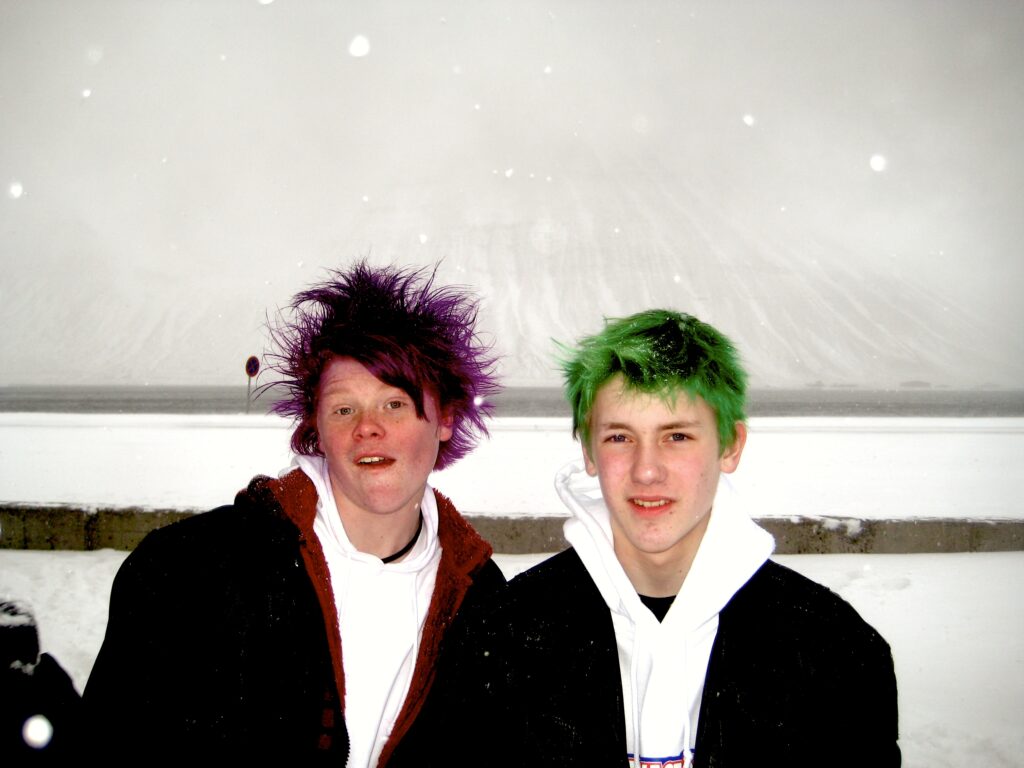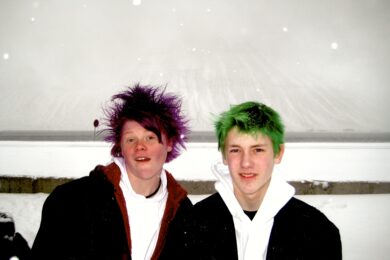PART ONE: A HIDDEN PLACE
There are about 12 of us seated at a table in the hotel restaurant, our eyes fixed on the plates in front of us. Outside, whiteout: white sky, white mountains reflected in icy white waters that reach up to blinding snow beyond our window, flakes drifting down like TV static confetti. We’re staring at a selection of local delicacies, one of the weirder ways in which we’re being encouraged to experience culture in Iceland’s West Fjords. Gazing back at us are slabs of meat, in a variety of sizes, meat that we have for inexplicable reasons volunteered to try. It’s unrecognisable, but that’s not the worst of it. The worst of it is that we’re about to eat puffin. Puffin and sheep’s head. And whale. Whale blubber, it looks like. And dried fish. (Looking back, that wasn’t so bad in comparison, just very dry indeed.) But then there’s the pièce de résistance, the speciality that provoked this entire gathering, the rare treat requested by the journalist from Hamburg. That’s the one we’re all looking at, the one we’re all talking about, the one we’ve in fact been discussing all morning.
I can smell it long before I allow myself to accept that I’m about to use a toothpick to spear a cube of hákarl, 40 year old rotten shark that’s been buried somewhere under the ground whilst the weight of the earth quite literally takes the piss out of it. Sharks don’t urinate, I’m surprised to learn. Fresh shark is about as unhealthy a fish as you can eat, we’ve been told. Told proudly, I might add. I lift the specimen towards my nose and sniff it tentatively.
"You don’t want to do that," the journalist from Cologne next to me warns. "It really doesn’t help."
I recall the grimace on his face as he took his first bite. He looked, as they say, like a bulldog that’s licked piss off a nettle. That’s because, to all intents and purposes, he had. And he’s right: it doesn’t help. It doesn’t help at all. The smell of ammonia and neglected public toilets floods my nose, almost bringing tears to my eyes, and my nostrils shrink in horror. I’ve taken on the challenge, however, and I’m not going to duck out now. Not in front of my girlfriend. The relationship is as fresh as the shark is not, and I want to impress her. So I sink my teeth into the rubbery flesh, chew on it valiantly, and let its taste spread across my tongue like an oil slick.
It’s indescribable. I don’t know if it’s sharp or sour, salty or sweet. It’s like nothing I’ve ever experienced. Then again, I probably wouldn’t be showing off if I were familiar with the flavour of stale wee. I realise I’ve got to get it down as fast as I can before the taste becomes a permanent, indelible fixture on my taste buds. I focus, take a deep breath and swallow. My throat immediately closes up. I gag violently. The hunk of shark is propelled back into my mouth. I clear my throat and try again, wincing, veins throbbing on my forehead. Again, purely instinctively, without any conscious effort, my throat tightens and I choke. The shark is volleyed upwards once more and lands behind my teeth. I think now there really are tears in my eyes. I reach for a shot glass of icy Brennivin and try to wash the lump down with a sip, but it’s no good. I can’t do it. In fact I think the decision’s about to be made for me: if I don’t spit this out right away I’m also going to lose the lump of puffin meat that I’ve somehow held down by admiring its unexpected citrus tang. I reach for my napkin and attempt discreetly to remove the evidence of my failure without anyone being disgusted by my actions. Beside me my girlfriend looks on with a mixture of amusement and absolute horror. I throw the rest of the schnapps down my neck. I’ve eaten raw whale blubber, and I’ve managed to keep down some form of blood sausage, its source now the subject of such trauma that I can’t remember what it was. My body, however, has drawn the line at the rotten flesh of a member of the team at the top of the marine food chain, a long dead shark that had inevitably swallowed every toxin yet to be expelled from the meals that the meals that the meals that the meals that the meals that the meals he’d just eaten contained.
But my girlfriend won’t be smiling in a moment. There’s one other thing at which I’ve consciously drawn the line. She’s going to eat sheep’s testicles, while I, on the other hand, have refused. I mean, seriously: that would be wrong. I know what balls are worth. I’m not going to encourage their sacrifice, whether they’re from a sheep or not. She, however, seems to think that the jellied scrotum in front of her is a viable meal. My girlfriend, I decide, clearly has balls herself, and it seems they’re bigger than mine. I should be humiliated, but I’m too busy anticipating her failure.
She slices off a chunk of ‘meat’, prods it with a fork, and then chows down. I watch her in amazement, in what I also slowly realise is admiration, as she chews the very essence of sheep. She swallows, politely takes a sip of water, and smiles mischievously at me. Impatiently, I ask how it tastes.
"Same as it ever was," she grins.
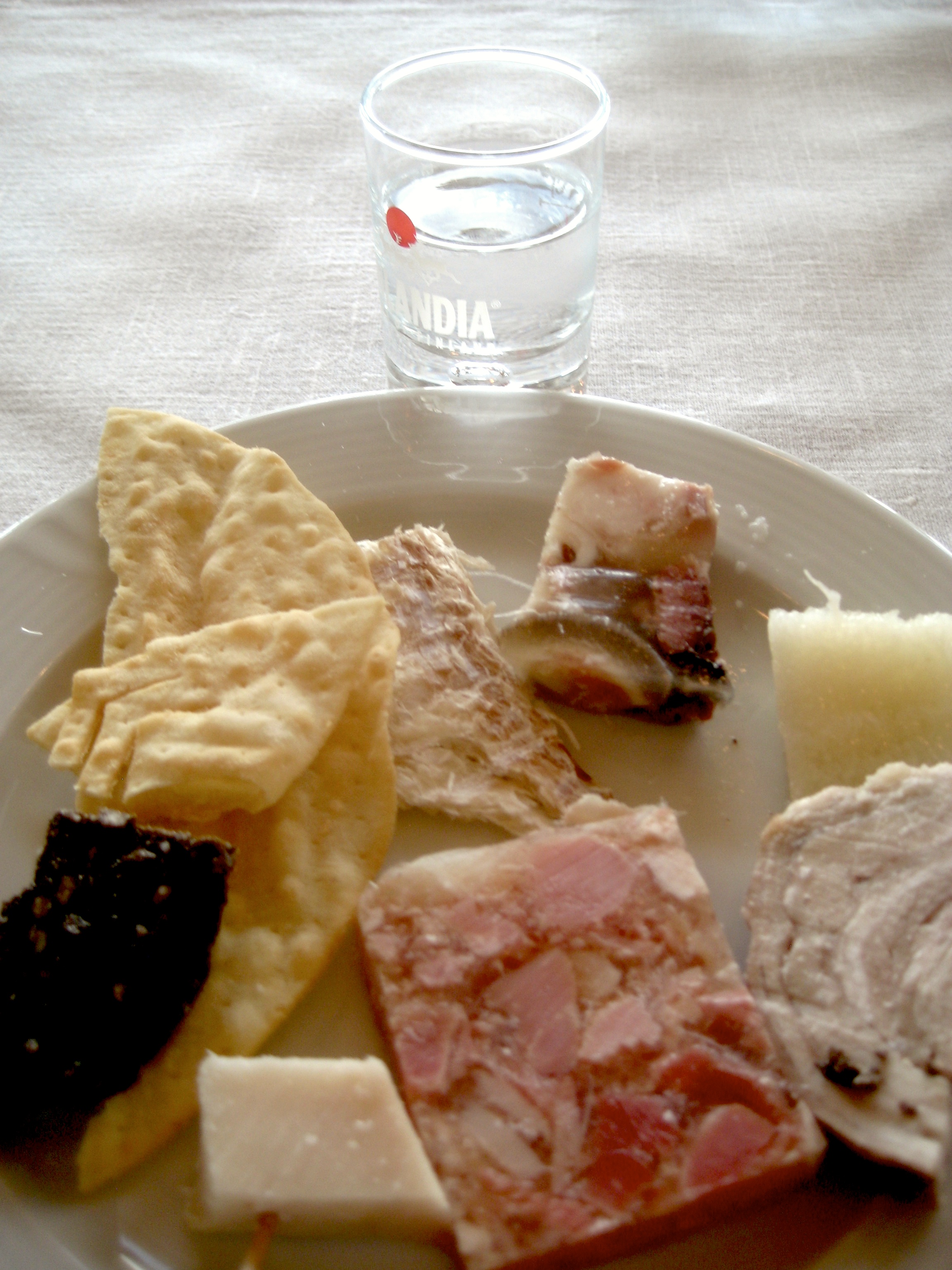
A sample of the local delicacies.
Nothing about this trip has been expected. That’s not just because I’ve never before been lucky enough to experience the magical pleasures of what really genuinely feels like a cross between the frozen ends of the earth and one of the most beautiful environments I’ve ever seen, inhospitable though Ísafjörður’s weather may well be from time to time. And by that, I mean most of the time this particular weekend. No, it’s because no one’s actually told me a thing. For a long time I didn’t know whether I was even going. Then I discovered I was flying out of London when in fact I live in Berlin. As it happened I was in the UK following my grandmother’s funeral, but almost the only clothes I had with me were black leather brogues, a second hand three piece pinstripe suit from a Nashville thrift store, a rather smart Aquascutum coat, also second hand, and an accidentally shrunken sweater for when I was ‘off duty’. I could rustle up a few more items before I flew, but this clothing issue still bothered me.
As it happened, an aunt I’d met at the funeral for the first time in many years was inadvertently able to help. She liked my outfit and thought that an old coat she had back in her antiques shop would suit me perfectly. And so she decked me out two days later in the most extraordinary fur I’d ever seen. As it hung from my shoulders I looked like a mutant breed of jive talking pimp, Siberian soldier marching on Berlin in 1945, and Cruella De Ville. Let’s put it this way: I did not look like a friend of Brigitte Bardot. And yet I didn’t know how to say no. The idea that I’d ever wear it was ridiculous, and yet for some reason her enthusiasm helped convince me that I might, under some absurd circumstance, some situation which I couldn’t predict right now but which I knew, deep down in my soul, was predestined to happen, under such a circumstance I might just be able to get away with it. So I accepted it graciously, ethically bothered by the idea of wearing fur and yet strangely certain that this coat was, somehow, as if it were fulfilling a prophecy far older than the shark, always intended to be mine at this particular point in my life.
But that was before I found out what an Astrakhan coat is. An Astrakhan coat comes from the fur of goats that cannot be any more than three days old if the pelt’s not to lose its lustre; goats that, in some cases, are taken from the bellies of mothers who have just been slaughtered for their foetuses. This, I decided, was a coat I simply could not wear. I left for London without it, unable to defend such a callous practice. I would write to my aunt and explain that I simply couldn’t accept her generosity, touched as I was, and hope she didn’t think I was a patronising prick.
Then I read the mail telling me I was leaving from London, not Berlin, followed by a weather forecast that warned of heavy snow, freezing temperatures and Arctic winds. At that point I called my parents and arranged to have the coat brought down to the capital. It was the only answer to the threat that I was otherwise likely to have my balls frozen off, and – as I would later discover – risk letting them become the potential target of Icelandic cuisine. Screw my ethics, screw my principles, screw my fear of receiving a glossy coat of Dulux while I enjoyed the music festival that I was being sent to cover. They’d understand, those lovely Icelanders. They’d forgive me for this. Christ, they were probably all wearing fur-lined coats and wrapping fox pelts round their necks themselves. The fact that I would be standing alongside them in what was formerly the outer layer of, I’d guess, about twenty wild goats probably wouldn’t even raise an eyebrow. In the meantime I’d be warm as you like, or at least as warm as twenty mountain goats. Needs, as they say, must.
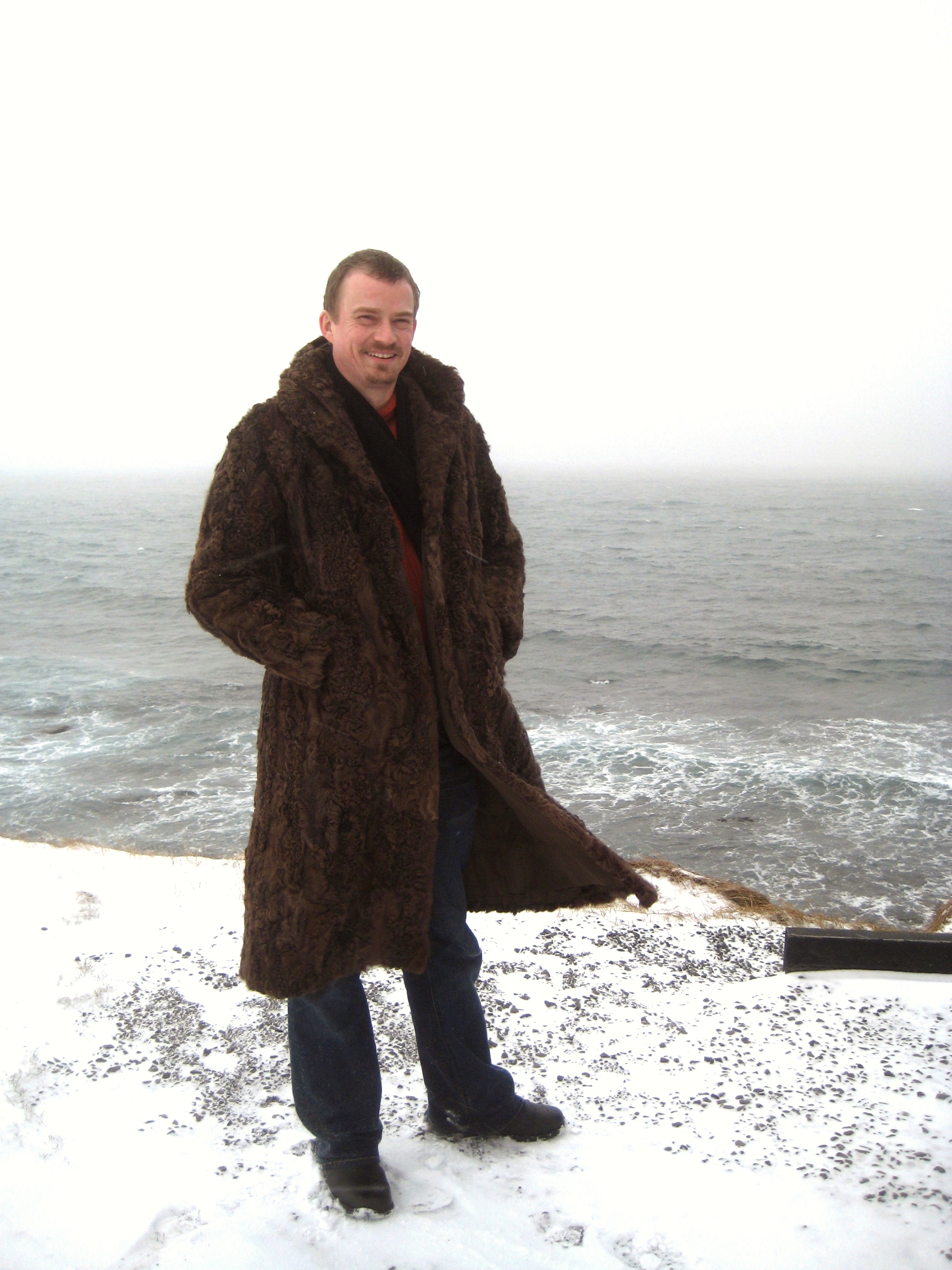
The author in his Astrakhan coat
I’m going to the Aldrei fór ég suður Festival, an annual event created by Icelandic musician Mugison, a gathering of bands from across all spectrums of music designed to give local people an excuse for a little fun. It is, I’ve been told, a two day party that has somehow encapsulated the very essence of the spirit of these isolated settlements. Or, at least, that would be one way of looking at it, if this were a somewhat shorter excuse for a story that needed a hook upon which to be hung. Whatever it is, though, the Aldrei Festival (as it’s often known) was dreamt up in 2003 by Mugison and his father, rather wonderfully known as Papamug, after the snow had failed the previous Easter and left the locals, who normally rely on visiting skiers for their income, high and dry. Since then it has become an accidental showcase of Icelandic musical culture that includes Balkan polka, sunshine pop, thunderous electronica, Icelandic blues, death metal, folk, indie rock and, this year, a new form of bling bling hip hop that will be delivered by a chubby cheeked kid who looks like he probably only mastered his ABC a few short years earlier.
Some indication of the days ahead appear in the form of a teenager waiting to board the forty minute flight to the West Fjords wearing only a pair of soccer shorts and a T-shirt. I’ve just smoked a cigarette outside the doors of the airport, and despite sporting my coat – already nicknamed the “yakky sack” – I’ve shivered violently. How that kid thinks he’s going to survive the considerably more extreme temperatures awaiting his arrival baffles me. But then again, how the pilot thinks he can possibly land his plane in the bay that comes into view as we descend into Ísafjörður is beyond me too. We’re flying into a mountain, for Christ’s sake. Fortunately the pilot notices this: he banks steep to the left, tipping us forty five degrees, and then – wings almost brushing the volcanic rocks to one side – we turn full circle and come in to land on a runway so short any disobedient plane would end up in the ocean. Our Captain must have had plenty of practice, it seems. In fact, I later discover, many pilots have: this landing is considered so extreme it’s used as a flight simulator exercise.
We’re met by Jon Pall, a local representative of the West Fjords Tourist Association, a musician and editor of The Reykjavik Grapevine called Haukur, and a camera team – also from Berlin – who immediately stick a camera in my face and ask how it feels to be in town. I notice the local residents staring as I gabble away in my Astrakhan coat, its collars reaching up to my chin. I realise that my eyes are rolling in my head as I look from the interviewer to the cameraman and round the airport’s minimal surroundings: I’m still giddy from the adrenalin that the recent landing has pumped into my system.
We pile our luggage into cars, and take a short drive along the coastline to a wooden house by the harbour. There we feast on a sublime fish soup, subtly spiced with cumin, a variety of fish and crab morsels lying at the bottom of the bowl. There’s more to follow, a peppery fish and potato stew with sweet malt bread that fortifies us for the freezing flakes that have now begun to obliterate the view of mountains clawing the waters like scarred fingers, their topsides frosted with fresh snow caught in the ravines like wrinkles.
Haukur makes a short welcome speech, assuring us that between him and his fellow hosts he’ll be able to get us anything we need.
"That includes hard drugs," he laughs.
"Soft drugs, too?" I joke.
"I suppose that might be possible," he reluctantly concedes.
Mugison introduces himself, leaning against one of the pillars charitably holding the roof up above our heads. Hugging a cup of coffee to his chest, he explains that the locals are ready and willing to accommodate us in any way they can. He tells us how his family home is just a little further down the fjord, introduces Papamug, who will himself be performing during the course of the festival, and offers to share recipes with us if we’re interested in cooking them back home. There’s an undeniable pride in his voice about the environment in which he lives. In fact, over the coming days, Mugison – along with his compadres – proves to be an amazing host. When the journalist from Hamburg asks if he can try another rumoured delicacy that will enable him to write his specialist culinary column, Mugison simply turns round and seemingly plucks out of thin air in less than a second an old man in his seventies who just happens to have a store of rotten seal at his disposal. (Conveniently, I miss this particular opportunity). But that’s the kind of guy Mugison is: despite living in the remotest part of this remote island he’s been able, year after year, to assemble an extraordinary line up of musicians who play for free, with no charge for tickets, and with locals working for sheer love of the principle. Permanently wrapped in a woolly sweater, with a woolly bobble hat atop his head, he exudes friendly charisma, charm and a gentle humility that make me want to hug him from the moment we first meet. He speaks fondly of a mutual acquaintance, Matthew Herbert, whose label, Accidental Records, released his early recordings, and compliments me on my coat. I blush and tell him that, given its origins, perhaps it’s nothing to be proud of, but he laughs and dismisses my concerns.
I run into Mugison in a café the next day after a drive up the fjords with my girlfriend has been brought to a premature halt. Conditions rendered it impossible to emerge from the car, and yet driving seemed like a simple death wish that could see us either tumbling into the ice encrusted sea beneath the cliffs or impaled on frozen icebergs hanging from what used to be waterfalls. He takes a moment to respond to my request for suggestions about places to visit and then excuses himself, saying that he’d been so focussed on my coat the previous afternoon that he’d failed to recognise me without it. This time he beckons over a local with keys to the town’s heritage museum, then sits down as we enjoy creamy hot chocolates and talks of the avalanches that have, on occasions, wiped out significant sections of housing in nearby villages, taking with them more than a handful of lives, and about the problems faced by local communities now that the fishing industry has been restricted. Some of these have been solved, he explains, by an organisation that has succeeded in persuading German tourists to pay for flights, accommodation and fishing trips, with the organisation then selling the fish they’ve caught.
"It’s like voluntary slave labour," he jokes. "Everyone’s a winner."
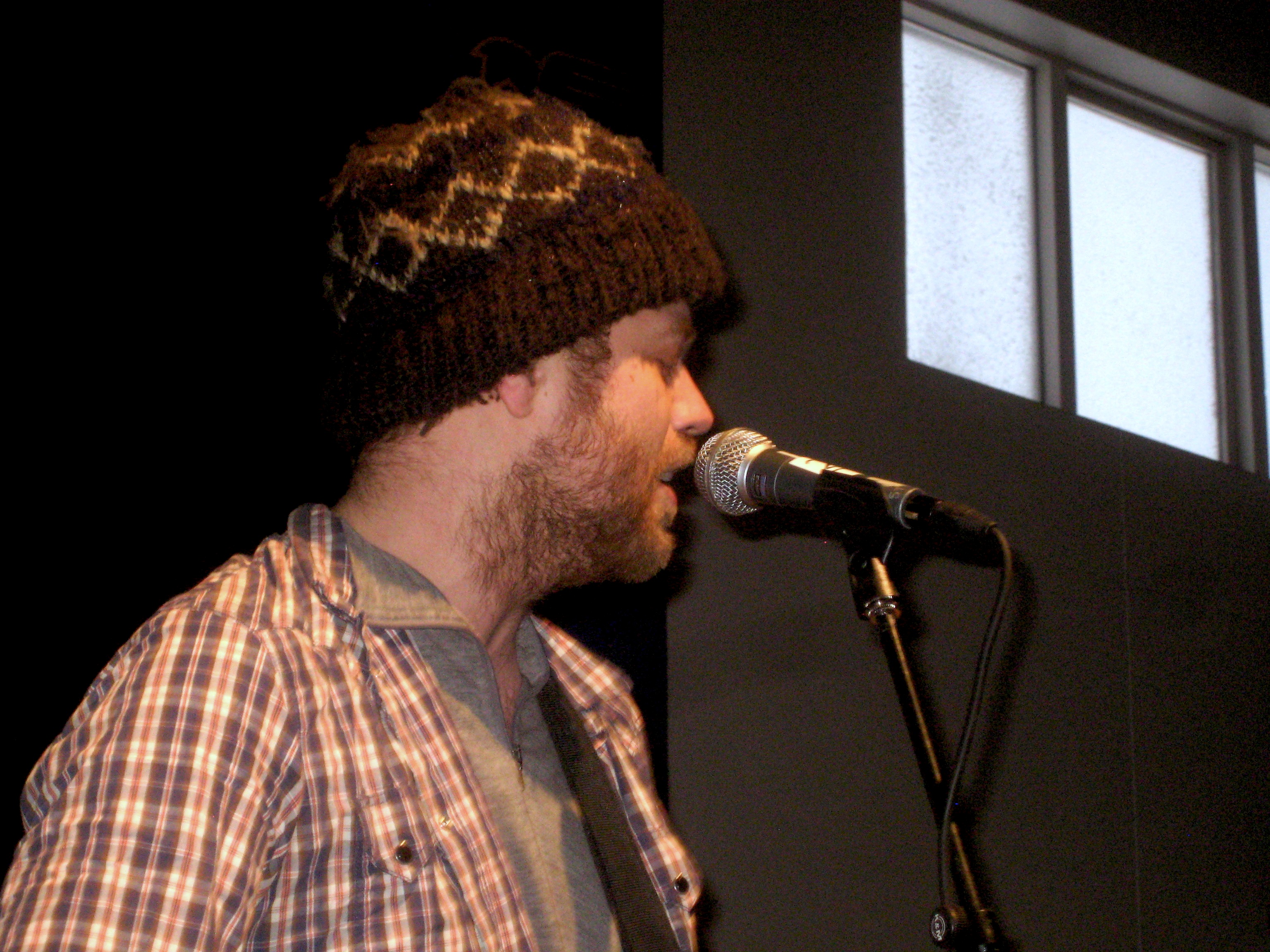
Mugison warms up the crowd
After we’ve checked into the simple but comfortable surroundings of the Hotel Ísafjörður, a stroll around the tiny town suggests that most of the population of 3-4,000 seem to be in hiding, and confirms that outside of this festival daily life offers few distractions. We find two restaurants, a bar strangely christened Krusin, a convenience store, a petrol station, a tiny harbour, a clutch of brightly painted houses in the traditional timber frame style, a church and a picturesque graveyard. At either end of the town there are corrugated warehouses and further anonymous concrete buildings stretched along the water. Somewhere amongst them, we’re inevitably told, there’s a swimming pool, though if we want to try out more adventurous waters such as Iceland’s legendary hot springs we’ll need to drive up the fjords to one of the other villages nearby.
It’s hard to believe this was once one of the most important settlements in Iceland. The industry here has declined since the introduction of fishing quotas, though colourful boats still bob in the harbour beneath vast black birds that kurr loudly overhead. I point my camera at almost everything I see, hypnotised by the white canvas of the hillsides and the objects lighting up the foreground. A pair of furlined boots that I’d gratefully managed to secure in a vintage store on Reykjavik’s high street leaves a trail of footprints in the virgin snow and the sun at last begins to light up a rich blue sky that curves overhead like a cathedral dome. Ísafjörður, the journalists from Cologne and Hamburg agree, may be quiet but it is, without any doubt, one of the most spectacular places our so-called ‘work’ has ever taken us.
At night the locals come out to play. A plate of fish and chips in what seems to be the favoured hang out for the municipality’s Slush Puppy-drinking youth – in other words, the aforementioned convenience store – provides early proof that Icelandic culinary tastes are somewhat different to those in mainland Europe. One of the documentary crew rescues us with a text inviting us to join him in the Krusin bar where he’s going to see Reykjavik play. My girlfriend is tired: she’s spent the previous week sleeping in a car while she explores the countryside and needs a good night’s rest. All the same, I ask if she’d mind accompanying me for one beer while we watch a little football on TV. As justification, I suggest it’ll give us a taste of an average night in town that could be vital for my research. So we descend wooden steps, fight our way to the bar through a heaving, sweating mass of lively Icelanders and order a couple of pints of Viking Beer. In the main part of the room a packed crowd fights for space around rows of seating facing a stage.
Reykjavik, it turns out, are not a football team. Instead Reykjavik! are a band, and they’re a band that rocks. A wild-haired woman, perhaps descended from the witches that allegedly populated the area in the 16th century, roars primitively into a microphone to signal the start of the show. A middle-aged lady in the front row meanwhile berates two men standing in front of her for blocking her view, but within minutes she’s allowed Reykjavik!’s regular male vocalist to clamber over her seat and into the crowd from where he yells into his mike, eyes bulging, as the band crunch out riffs behind him. Our host Haukur is playing guitar, I realise, but we’ve only got eyes for the singer who threatens to knock beers out of the hands of every audience member, beers which those unused to the local prices clutch tightly to their chest. In the end, despite the band’s ferocity, we don’t last long: the sheer volume of people pushing behind us, many of them keen to stroke my coat vigorously, forces us to retire to the back where we lounge on battered leather seats and chuckle at the loose limbed locals tripping over their own feet in an effort to remain standing. Necking the last of our beer, we decide there will be plenty more music over the next few days and elect to retire for the evening. Given the number of folk still streaming down the staircase, we have a hunch that if we don’t leave soon it might be morning before we get through the crowd. It turns out we’re almost right: by the time we’ve made it back to the street, Reykjavik!’s set has come to an end.
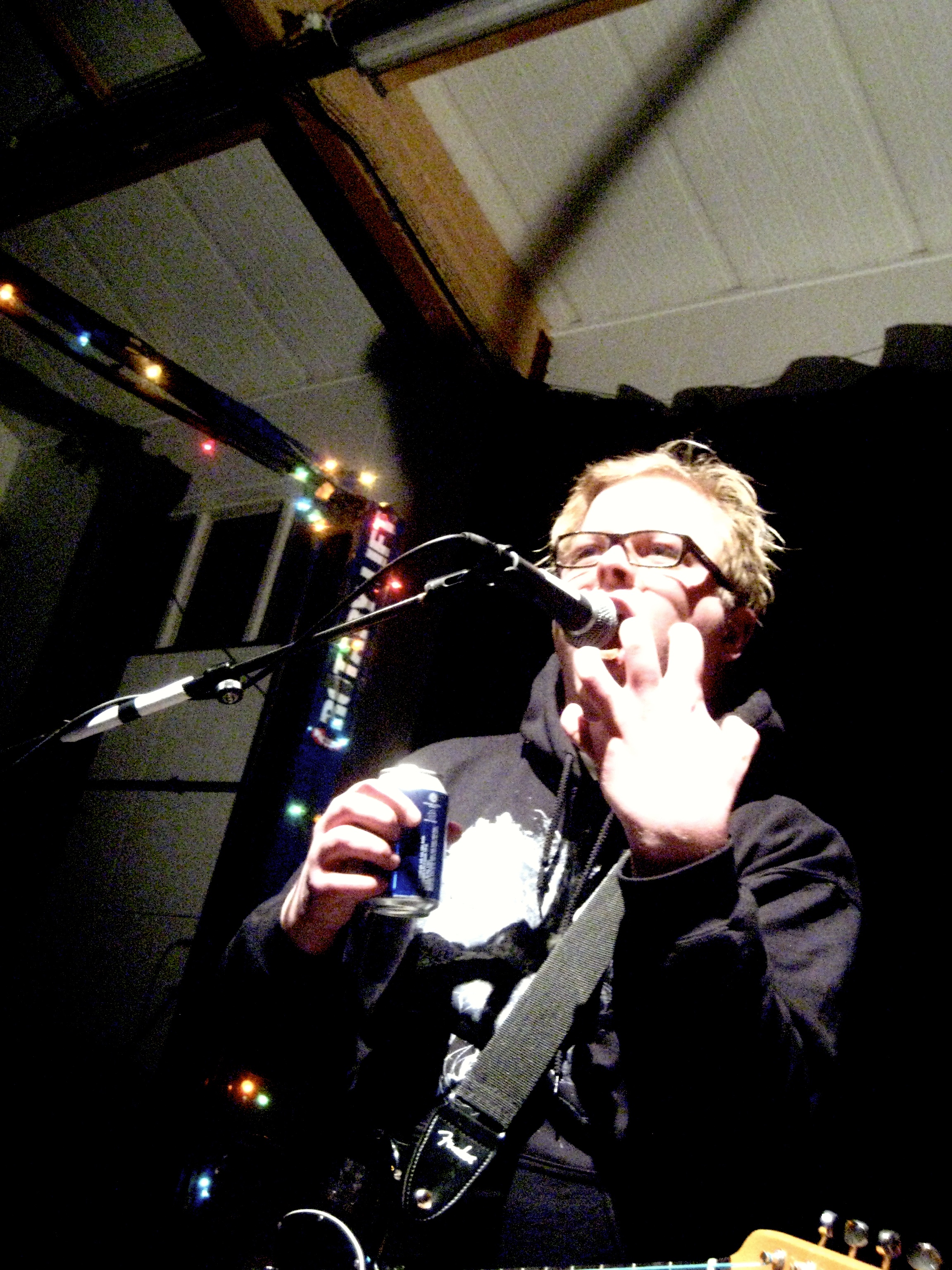
Reykjavik!’s Haukur tries out his doom claw
We wake the next day to find the town blanketed in snow. After our swiftly curtailed trip to nearby Bolungarvik, its highlight the brief stop-off we made at two grass-roofed cottages overlooking a black sandy beach close to a fish drying rack whose musty perfume filled the air, we’re driven by Mugison’s key-holding friend to the heritage museum. It’s only 500 metres away, but in this kind of weather we’re more than happy to accept his hospitality.
"Don’t you ever wish you lived somewhere like Jamaica?" I ask him flippantly before we step out of the car into a swirling blizzard.
"Not at all," he replies firmly. "The winters might be hard, but sometimes the summers are quite mild." Icelanders, though I hate to generalise, have a talent for understatement.
He guides us through the dimly lit ground floor of the museum, apparently Iceland’s oldest house built in 1734. The smell of creosote blends with that of more dried fish in one corner of the room and the scent of ancient sheepskin overalls in another. A brief summary of the town’s history highlights the harsh realities of lives spent hunting beasts as big as whales and creatures as small as shrimp. Oddly, the museum also houses an enormous collection of accordions dotted around its three floors. Our guide points to a door behind an obsolete radio console.
"The man who used to own the accordions," he tells us, "he has his own room there where he fixes the broken ones."
"Does he ever give concerts?" I enquire.
"Not really," our guide laughs. "He’s not really the best accordion player."
I refrain from asking what could possibly have inspired him to assemble a collection of 400 accordions. I suspect the answer may simply be that he needed something to do.
We wander around, absorbing stories of Russian driftwood that takes four to five years to wash up on Icelandic shores, examining information about the limited number of birds that populate the desolate countryside, and testing the points of harpoons used to penetrate the bodies of minke whales. A red diving suit with a massive metal helmet stands in the shadows and I flash back to childhood dreams inspired by Tintin and Red Rackham’s Treasure. I’m living a Tim Burton fantasy: I’m standing at the ends of the earth with a beautiful girlfriend who little more than a month ago I’d never even met, in a wooden house two and a half centuries old, the roof is rattling as it’s pounded by strong winds. We’re surrounded by the kind of fabulous objects and scenery that were, to me at least, not so long ago – certainly in a shorter time than it takes to ferment and render a shark non-toxic – merely the stuff of fiction. I’m swept up in the romance of it all, my sentimental nature seduced by a life that I, as a soft-skinned city dweller, know I could never live but which I rather wish I could. The windows rattle as another icy blast shakes the building. I take my girlfriend’s hand and give it a squeeze.
It’s 6pm on Friday night, and after a short drive from the town centre – or for those braver than us, after a rather less inviting and terrifyingly slippery walk – we find ourselves in a high roofed metal hangar, one side open to the elements. The front of the stage is filled with children perched by the monitors, ski hats their only protection against the sound system. Most choose to ignore the three smartly suited gentlemen at whose feet they sit, opting instead to hug teddy bears as they gaze out over the crowd. The sound of saxophones, a trombone and what seems to be some kind of squeezebox, perhaps borrowed from the heritage museum, seems to be causing some confusion amongst my journalist colleagues. But the crowd are thrilled, especially when a young boy is brought on to read from what we assume is a poetry book, though such is the unfamiliarity of the Icelandic language he could be delivering the evening’s running order or perhaps reading the weather forecast. My view is blocked by a child hoisted onto his father’s shoulders, the AC/DC logo on the back of the youngster’s shirt glowing in the light cast by the fluorescent strips overhead. Outside, the only punks in the village are throwing snowballs at each other, their purple and green hair stark against the mountains behind. They pose for a photograph, amused as much by my coat as my request, and are soon hauled over by the camera crew.
"What’s there to do in Ísafjörður?" they’re asked.
"Nothing," they reply sulkily.
"Well, where would you rather be?"
"Kingston," they laugh. It continues to snow.
A journalist from London joins us. He wonders if we know where he can get a glass: in his bag he has a bottle of rum and another of Coke, but he’s brought nothing in which to mix them. We suggest a trip to the car for a little vorspiel: we can provide a bottle of gold filtered Russian vodka, a hipflask of rather less palatable Smirnoff, and a couple of litres of fruit juice. The only music we have is the new album by Cibelle, but as her magical take on Monty Norman’s ‘Underneath The Mango Tree’ – whose original version was first sung by Ursula Andress in Dr. No – kicks in, the heating begins to melt ice off the windscreen. We pass around cups of powerful cocktails as the tropical vibes overwhelm us, and we sing along, cranking up the volume for a second play so we can dance in the snow while we smoke.
By the time we head back towards the hangar the alcohol has gone to our heads. Mugison’s on stage, only the fourth act on a bill of fourteen bands tonight (with another twenty or so due tomorrow) happy to come all this way for a mere twenty minutes of limelight. It’s typical of the festival’s ethos that he should appear so low on the bill, and the welcome he receives from the swiftly growing audience is fit for a conquering hero. The fond regard in which the locals hold him is genuinely touching. It’s quite a surprise, given the experimental nature of his early glitch-pop albums, to see him playing an acoustic guitar backed by a drummer and bassist who bang out a succession of crowd-pleasing indie rock numbers, but these prove to be amongst the weekend’s highlights. Equally impressive, however, is the turnaround between acts: rather than insisting on the lengthy soundchecks that blight many concerts, bands here file on and off stage leaving punters barely enough time to visit the Portaloos. Everyone’s here for the right reason: to play and share music with the minimum of fuss.
Mugison is followed by Lára Runárs, though the only reason we’re sure is because the running order has finally been scrawled on a couple of planks of chipboard nailed to one of the walls. Dressed in a splendid woollen shawl that seems to be decorated with blue donuts, her summer pop warms the crowd, almost as though they’ve joined us underneath our mango tree, and we’re excited to spot bassist Jakob Smári Magnússon, a former member of Tappi Tikarrass, one of Björk’s early bands. We realise as the evening goes on, however, that – like most Icelandic musicians – Mr Magnússon has many a musical mistress, clambering back on stage on at least two more occasions. Soon we’re enjoying Bróðir Svartúlfs’s laid-back melodies, rapped out over a live band who seem to have spent a lot of time listening to Sigur Rós, but poor Ólöf Arnalds, a member of Múm’s touring band and also the cousin of Ólafur Arnalds, has to fend for herself afterwards with just an acoustic guitar for company. Against the chatter it’s hard to decide whether she’s anything more than yet another singer-songwriter, but a dedicated following down the front swoon at her every tune.
As we’ve learned to expect, though, nothing here happens as one might expect. We fight our way back to the front for Reykjavik!, who’ve been added to the bill after their singer’s flight home was cancelled due to inclement weather, only to find out that they’ve postponed their appearance to make way for Veðurguðirnir. Veðurguðirnir, it soon becomes clear, are really rather popular with Ísafjörður’s teenage girls who rush to the front, pinning rockers up against one another by the barriers. Surprisingly, said rockers seem thrilled by the anodyne, vanilla pop that so pleases the pubescent blondes that our view is obscured by a sea of outstretched hands reaching for the band. Young Icelandic girls, it seems, are not shy when it comes to making their affections felt. As they shove me excitedly from side to side I’m thrust violently up against a photographer. I ask if she’s OK.
"I feel violated," she shouts back at me. I’m not sure if she’s joking.
"Trust me," I tell her as teenage screams threaten to drown out the band and aggravate my tinnitus, "it’s even worse where I’m standing."
It’s not really, though. There may be a mass of bodies crushing me, but the only reason I have to feel violated is that, wherever I go, people want to stroke my coat. Some ask permission, but most don’t wait for an invitation. I even discover the only punks in the village caressing my back. I’m not quite sure what they’re doing there singing along to Veðurguðirnir, but it’s clear I’m one of the few who’s left cold by a relentlessly perky pop that makes Coldplay sound like rabid dogs. Surely my new punk friends would be better off watching Reykjavik!? Their storming set a little later is so animated it concludes with Haukur going topless.
The night ends with Bloodgroup, their singer, dressed in what appears to be some kind of Gothic nightgown, looking like she just arrived from the set of a zombie movie. Like her colleague, who twists and contorts himself in such an overly theatrical fashion that he repeatedly loses his hat, she’s trying just a little too hard, and their hackneyed revivalist electro-pop is further undermined by a cover of, ironically, Men Without Hats’ ‘Safety Dance’. Again, though, my own response is negated by wild screams and a vicious scrum upfront that is further enlivened when our hat-juggling star decides to tear open his shirt. Before my cynicism gets the better of me, however, the journalist from London pushes his way in my direction, his eyes betraying a sense of panic.
"They’re not that bad," I shout.
"I know," he yells, his face so close to mine that I can feel his breath. “That’s not the problem. I’ve lost my… I’ve lost my… I’ve lost my… I’ve lost my…”"
I take a step back and realise he’s drunk.
"I’ve lost my…” he continues. "I’ve lost my… I’ve lost my…"
"Dude," I finally interrupt, "you’re a journalist! You’re supposed to be good with words!"
"I’ve lost my rucksack!" he announces victoriously.
I understand his concern, especially when he explains that his Dictaphone is missing too, and yet somehow I’m certain that no harm will be done. He seems reassured.
"I suppose you’re right," he says. "It’s not that kind of place, is it?"
We offer him a lift back to town. My girlfriend’s infinitely more sensible than anyone else in the city, it seems, and hasn’t touched a drop since we left our cocktail party almost eight hours earlier. We park up amongst snowdrifts in the shelter of a dilapidated house, its pale green paint peeling off rusty corrugated metal. The journalist from London tumbles out of the car.
"Who’s coming for another drink?" he asks.
We politely decline the offer. After an evening this long we’d rather save some energy for tomorrow.
"Oh, come ON!" he complains. "Don’t be shy! Come and have a party!"
"No, really," I say. "We’ll walk you to the Krusin Bar. You won’t be short of company there."
Behind us we hear the crunch of footsteps in the snow. The journalist from London staggers towards the source and puts his arm around one of four young Icelandic ladies who look similarly the worse for wear.
"Are you going to a party?" he asks. "Let’s go to a party. Yeah?"
That’s a good idea," she replies as he staggers beside her comically. "Let’s go to a party! Yeah!"
"He’s all yours," I smile to myself, and lead my girlfriend back to the hotel.
Part 2 of ‘Don’t Be Afraid, You Have Just Got Your Eyes Closed’ will be published next week

